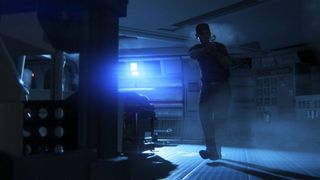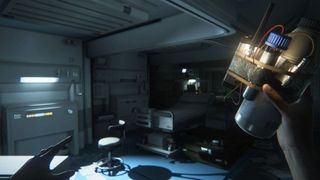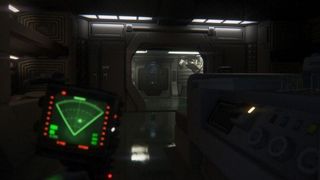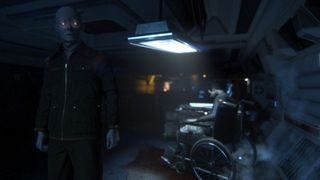Alien: Isolation E3 hands-on

Playing Alien: Isolation felt like learning how to swim for the first time. When you're first dropped into Sevastopol space station (through an air duct in the ceiling, in my case), there's a feeling of total uncertainty about what's safe and what isn't. Where can I hide? When is it okay to run? Will the alien see me under this desk? How far away can a gunshot be heard? How long will cowering in a locker like a bullied teen protect me from a nine-foot-tall alien death machine?
Being left—being trusted—to answer those questions through my own bravery, anxiety, and failure was really satisfying. The half-hour section I played seemed pretty early into Alien: Isolation, and it was absent of any clumsy hand-holding or tutorial. The demo didn't cover much physical distance, but I had to consider each step carefully. After gathering a few materials I'd use later for crafting, I stepped toward the only exit in the locker room I'd dropped into. The automatic door parts with a pneumatic woosh, and the first thing I see is a body slumped on the ground blood smeared across the bulkhead. The only light sources in this section of the ship are auxiliary, but I decide to keep my flashlight off, not knowing whether it'll alert the alien.
The Sevastopol, even with the layer of grimness splattered atop it, is gorgeously rendered in the style of '80s sci-fi. Chunky electronics sit at workstations, their green screens glowing. Everything is lightly rounded, sterile, generally beige or pearl. It's a very pleasant aesthetic, despite the occasional corpse.
I curl around a few more corridors, never leaving the crouched position, peeking my head into the vacant labs and areas I pass along the way. I haven't seen or heard the alien, but I'm moving more carefully than I ever have in a video game. The sound design makes me hyperattentive to my movements, orientation, what level of light I'm standing in.

It's at this point that I start to develop a relationship with the motion tracker, a piece of equipment that barely leaves my hands for the remainder of the playthrough. A single blip populates its Game Boy-green screen, an abstract reminder that the alien is lurking unseen in station's air vents. It's an extremely helpful device, but it also, at least this early into my time playing, feels necessary in an interesting way, and not like a crutch. The motion tracker isn't simply a way of mitigating my fear and giving me more control; if anything, knowing exactly how close the alien is, or that it's sprinting toward me, puts me more on edge.
As I plod on, dodging the alien in lockers or under beds, I'm able to make it unscathed to a central area of the Sevastopol where looters are lurking. They're holding pistols, but I know that getting into a firefight with the flamethrower and pistol I'm carrying would only pan out as 'whoever wins, we lose.' There's another way to deal with the looters, thankfully. I crouch underneath a medical station, reach into my crafting menu, and use the materials I've gathered to make a noisemaker that I then lob down the corridor. The looters chatter, baffled at what's cause the racket that's about to get them killed, but the alien is on them in seconds, gutting them unceremoniously, striding confidently from prey to prey.

This was the only few minutes that pulled me out of Isolation's otherwise gripping immersion, actually. The alien's animations were a little disconnected as it turned on its heels too quickly to find another target, and it didn't flinch when looters or I, both foolishly, unloaded into it at point-blank range, seemingly deflecting bullets with its skin. I don't expect the thing to bleed, but it's a strange to not have an enemy react at all when you shoot it.
The biggest gaming news, reviews and hardware deals
Keep up to date with the most important stories and the best deals, as picked by the PC Gamer team.

Eventually I came to a level section that ended up being just as terrifying as my encounters with the xenomorph. In a generator room, sealed off from the alien, I had to complete a quick puzzle at a command station in order to activate an emergency system. Between me and that, though, was a synthetic: a glassy-eyed android programmed to stop me. We were trapped in this tiny, symmetrical square room, and he chased me tirelessly, barking commands. Meleeing and lighting it on fire did absolutely nothing. A headshot didn't kill it. Was I missing something? I looked for environmental clues. I shot a red barrel that didn't explode. Red barrels are always supposed to explode! Finally, after minutes of panicked fleeing, my last bullet chambered, I weakly pointed it back at the synthetic. A second headshot put him down, crumpling him into a sputtering, still-scary mess on the floor. Phew .

Isolation makes you realize that every Alien game for the past decade has been a thematic mismatch. Alien isn't about its marines, its pulse rifle, or its action. It's about fear, uncertainty, and how a single, fragile human copes with a genetically superior monster-predator. It's wonderful to see Sega supporting a premise—admittedly after supporting one or two other conventional directions for Alien that didn't pan out—that's driven by emergent storytelling and trusting that the game's systems are well-enough designed to produce a great experience for everyone.

Evan's a hardcore FPS enthusiast who joined PC Gamer in 2008. After an era spent publishing reviews, news, and cover features, he now oversees editorial operations for PC Gamer worldwide, including setting policy, training, and editing stories written by the wider team. His most-played FPSes are CS:GO, Team Fortress 2, Team Fortress Classic, Rainbow Six Siege, and Arma 2. His first multiplayer FPS was Quake 2, played on serial LAN in his uncle's basement, the ideal conditions for instilling a lifelong fondness for fragging. Evan also leads production of the PC Gaming Show, the annual E3 showcase event dedicated to PC gaming.
Most Popular



